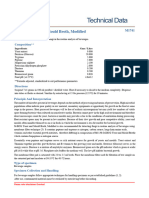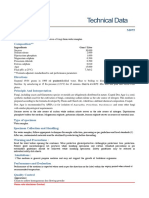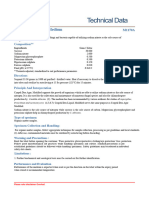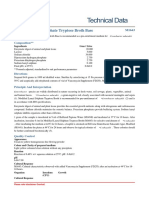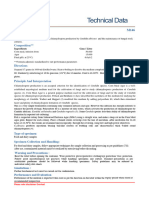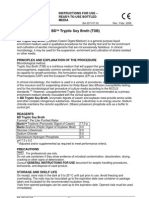Technical
Technical
Uploaded by
nafiw31466Copyright:
Available Formats
Technical
Technical
Uploaded by
nafiw31466Original Title
Copyright
Available Formats
Share this document
Did you find this document useful?
Is this content inappropriate?
Copyright:
Available Formats
Technical
Technical
Uploaded by
nafiw31466Copyright:
Available Formats
Boric Acid Broth M216
Intended use
For the detection and presumptive identification of Escherichia coli on the basis of this organism to grow at 43°C and form
gas in the presence of boric acid
Composition**
Ingredients Gms / Litre
Proteose peptone 10.000
Lactose 5.000
Dipotassium hydrogen phosphate 12.200
Potassium dihydrogen phosphate 4.100
Boric acid 3.250
Final pH ( at 25°C) 7.0±0.2
**Formula adjusted, standardized to suit performance parameters
Directions
Suspend 34.55 grams in 1000 ml purified/distilled water. Dispense in test tubes with inverted Durham’s tubes. Sterilize
by autoclaving at 15 lbs pressure (121°C) for 15 minutes. For inocula larger than one ml, the medium should be
prepared in proportionately greater concentration. A pH indicator may be added if desired.
Principle And Interpretation
Boric acid has been used as a medium for the detection of E.coli from foods and water. This medium has been suggested by
Levine et.al (5). When isolates from agar slant or samples are inoculated into lactose broth and boric acid broth. Only E.coli
grow and produce gas in both the broths, while Aerobacter species grow only in lactose broth (1).
Proteose peptone supplies carbon, nitrogen substances, long chain amino acids, vitamins and other growth supplements to
the microorganisms. Lactose is the fermentable carbohydrate. Phosphates buffer the medium. Boric acid allows the growth of
E.coli.
Type of specimen
Food samples; Water samples.
Specimen Collection and Handling:
For food samples, follow appropriate techniques for sample collection and processing as per guidelines (6).
For water samples, follow appropriate techniques for sample collection, processing as per guidelines and local standards (2).
After use, contaminated materials must be sterilized by autoclaving before discarding.
Warning and Precautions :
Read the label before opening the container. Wear protective gloves/protective clothing/eye protection/ face protection.
Follow good microbiological lab practices while handling specimens and culture. Standard precautions as per
established guidelines should be followed while handling specimens. Safety guidelines may be referred in individual
safety data sheets.
Limitations :
1. Further biochemical testing is required for complete identification.
Performance and Evaluation
Performance of the medium is expected when used as per the direction on the label within the expiry period when stored at
recommended temperature.
Please refer disclaimer Overleaf.
HiMedia Laboratories Technical Data
Quality Control
Appearance
Cream to pink homogeneous free flowing powder
Colour and Clarity of prepared medium
Light amber coloured clear solution
Reaction
Reaction of 3.46% w/v aqueous solution at 25°C. pH : 7.0±0.2
pH
6.80-7.20
Cultural Response
Cultural characteristics observed after an incubation at 43°C for 18 - 24 hours.
Organism Inoculum Growth Gas
(CFU)
Escherichia coli ATCC 50-100 luxuriant Positive
25922 (00013*) reaction
# Klebsiella aerogenes 50-100 inhibited Negative
ATCC 13048 (00175*) reaction
Salmonella Typhi ATCC 50-100 inhibited Negative
6539 reaction
Key : (#) Formerly known as Enterobacter aerogenes (*) correspondind WDCM numbers
Storage and Shelf Life
Store between 10-30°C in a tightly closed container and the prepared medium at 15-25°C. Use before expiry date on
the label. On opening, product should be properly stored dry, after tightly capping the bottle in order to prevent lump
formation due to the hygroscopic nature of the product. Improper storage of the product may lead to lump formation.
Store in dry ventilated area protected from extremes of temperature and sources of ignition Seal the container tightly
after use. Use before expiry date on the label.
Product performance is best if used within stated expiry period.
Disposal
User must ensure safe disposal by autoclaving and/or incineration of used or unusable preparations of this product. Follow
established laboratory procedures in disposing of infectious materials and material that comes into contact with sample must
be decontaminated and disposed of in accordance with current laboratory techniques (3,4).
Reference
1. A. Njoku-Obi and C. E. Skinner. Boric Acid Lactose Broth as a Medium for the Detection of Fecal Coliform Bacteria.
Appl Microbiol. 1957 March; 5(2): 80–82.
2. Baird R.B., Eaton A.D., and Rice E.W., (Eds.), 2015, Standard Methods for the Examination of Water and
Wastewater, 23rd ed., APHA, Washington, D.C.
3. Isenberg, H.D. Clinical Microbiology Procedures Handbook 2nd Edition.
4. Jorgensen, J.H., Pfaller, M.A., Carroll, K.C., Funke, G., Landry, M.L., Richter, S.S and Warnock., D.W. (2015)
Manual of Clinical Microbiology, 11th Edition. Vol. 1.
5. Levine, M., Epstein S.S.,1934. Differential reactions in the colon group of bacteria. American Journal of Public
Health.24-505-510
6. Salfinger Y., and Tortorello M.L. Fifth (Ed.), 2015, Compendium of Methods for the Microbiological Examination of
Foods, 5th Ed., American Public Health Association, Washington, D.C.
Revision :03 / 2019
Disclaimer :
User must ensure suitability of the product(s) in their application prior to use. Products conform solely to the information contained in
this and other related HiMedia™ publications. The information contained in this publication is based on our research and development
work and is to the best of our knowledge true and accurate. HiMedia™ Laboratories Pvt Ltd reserves the right to make changes to
specifications and information related to the products at any time. Products are not intended for human or animal or therapeutic use but
for laboratory,diagnostic, research or further manufacturing use only, unless otherwise specified. Statements contained herein should not
be considered as a warranty of any kind, expressed or implied, and no liability is accepted for infringement of any patents.
HiMedia Laboratories Pvt. Ltd. Reg.office : 23, Vadhani Ind.Est., LBS Marg, Mumbai-400086, India. Customer care No.: 022-6116 9797 Corporate office :
A-516,Swastik Disha Business Park,Via Vadhani Ind. Est., LBS Marg, Mumbai-400086, India. Customer care No.: 022-6147 1919 Email:
techhelp@himedialabs.com Website: www.himedialabs.com
You might also like
- Pharmaceutical Microbiology: A Laboratory ManualFrom EverandPharmaceutical Microbiology: A Laboratory ManualRating: 3.5 out of 5 stars3.5/5 (3)
- As NZS 1841.1-2007 Portable Fire Extinguishers General RequirementsDocument9 pagesAs NZS 1841.1-2007 Portable Fire Extinguishers General RequirementsSAI Global - APAC0% (1)
- Parts Catalog Af1060-1075-2060-2075-2051 (B064-065-140-141-142-143-163-228) PDFDocument312 pagesParts Catalog Af1060-1075-2060-2075-2051 (B064-065-140-141-142-143-163-228) PDFEdwin BautistaNo ratings yet
- Sabouraud Dextrose Broth (Sabouraud Liquid Medium) : Intended UseDocument3 pagesSabouraud Dextrose Broth (Sabouraud Liquid Medium) : Intended UseCintya Arum SariNo ratings yet
- MH144 SJSMSNDocument3 pagesMH144 SJSMSNsulistyani sapardiNo ratings yet
- Technical Data: Plate Count Agar (Standard Methods Agar)Document2 pagesTechnical Data: Plate Count Agar (Standard Methods Agar)பொ.தெய்வராஜன்No ratings yet
- Inserto HimediaDocument3 pagesInserto HimediayyewelsNo ratings yet
- M121IDocument2 pagesM121IventyfaniaNo ratings yet
- Peptone Water: Intended Use: CompositionDocument3 pagesPeptone Water: Intended Use: Composition10605114No ratings yet
- Tryptic Soya Agar: Intended UseDocument2 pagesTryptic Soya Agar: Intended UseGopi NathNo ratings yet
- Chloran Rose Bengal Chloramphenicol Agar (DRBC Agar) : Intended UseDocument3 pagesChloran Rose Bengal Chloramphenicol Agar (DRBC Agar) : Intended Useபொ.தெய்வராஜன்No ratings yet
- M-BCG Yeast and Mould Broth, Modified: Intended UseDocument3 pagesM-BCG Yeast and Mould Broth, Modified: Intended UseWilliamNo ratings yet
- Pseudomonas Agar (For Pyocyanin) (In A Accordance With IP 2007)Document2 pagesPseudomonas Agar (For Pyocyanin) (In A Accordance With IP 2007)sezinaltiokkNo ratings yet
- Himedia M933Document3 pagesHimedia M933linaNo ratings yet
- Plate Count Agar (Standard Methods Agar) : Intended UseDocument3 pagesPlate Count Agar (Standard Methods Agar) : Intended UsenuraenirianNo ratings yet
- Malt Extract Agar: Intended UseDocument3 pagesMalt Extract Agar: Intended UseMimma MonicaNo ratings yet
- MH096Document3 pagesMH096Rocío CPérezNo ratings yet
- BHI BrothDocument3 pagesBHI BrothHà Anh Minh LêNo ratings yet
- Sabouraud Cycloheximide Chloramphenicol Agar: Intended UseDocument3 pagesSabouraud Cycloheximide Chloramphenicol Agar: Intended UsenadyasantikaNo ratings yet
- M008SDocument3 pagesM008Sanulorance98No ratings yet
- MM242Document3 pagesMM242Anand H SNo ratings yet
- Hicrome™ Ecc Selective Agar Base: Intended Use: CompositionDocument3 pagesHicrome™ Ecc Selective Agar Base: Intended Use: Compositionafiifa1015No ratings yet
- Czapek Dox Agar: Intended UseDocument2 pagesCzapek Dox Agar: Intended Useo8o0o_o0o8o2533No ratings yet
- Czapek Dox MediaDocument2 pagesCzapek Dox MediaPamela ChavesNo ratings yet
- EMB Agar: Composition Intended UseDocument3 pagesEMB Agar: Composition Intended UseAbdulrahmanNo ratings yet
- M001 PDFDocument3 pagesM001 PDFkeresahanmuNo ratings yet
- Broth: Intended UseDocument3 pagesBroth: Intended UseRaga PreethikaNo ratings yet
- Clostridial Agar: Intended UseDocument3 pagesClostridial Agar: Intended Usesg.comNo ratings yet
- MH581Document3 pagesMH581Abid Iqbal ARDNo ratings yet
- Nutrient Agar 2Document3 pagesNutrient Agar 2Khaza VinodNo ratings yet
- M1643 LSTB MediumDocument2 pagesM1643 LSTB Mediumayuningtyas wahyuNo ratings yet
- Corn Meal Agar: Intended UseDocument2 pagesCorn Meal Agar: Intended Usealbdanyghmdan609No ratings yet
- TDS M198Document3 pagesTDS M198Muhammad ErdiansyahNo ratings yet
- MP5332Document3 pagesMP5332satyen.ghosh1111No ratings yet
- TDS MH443Document3 pagesTDS MH443florengrace.fg98No ratings yet
- Gifu Anaerobic Broth (GAM) : Intended UseDocument3 pagesGifu Anaerobic Broth (GAM) : Intended UseVishwanath Unique BiotechNo ratings yet
- Acetate Agar: Intended UseDocument2 pagesAcetate Agar: Intended UseMIcro LabNo ratings yet
- CR014Document3 pagesCR014Nabila Putri SabilaNo ratings yet
- Technical Data: Peptone WaterDocument3 pagesTechnical Data: Peptone WaterAbdulrahmanNo ratings yet
- M1297ADocument3 pagesM1297Ateena jacobNo ratings yet
- Kovac's Indole Reagent: Intended UseDocument2 pagesKovac's Indole Reagent: Intended UseShamim MahmudNo ratings yet
- Technical Data: Enriched Thioglycollate BrothDocument3 pagesTechnical Data: Enriched Thioglycollate Brothபொ.தெய்வராஜன்No ratings yet
- Stuart Transport Medium (Transport Medium, Stuart) : Intended UseDocument3 pagesStuart Transport Medium (Transport Medium, Stuart) : Intended Useradiny audiaNo ratings yet
- M1990IDocument2 pagesM1990IDr. Shantanu KodapeNo ratings yet
- RM007Document3 pagesRM007Gopi NathNo ratings yet
- Urea Broth Base (Diagnostic Stuarts Urea Broth Base) : Intended UseDocument3 pagesUrea Broth Base (Diagnostic Stuarts Urea Broth Base) : Intended Use10605114No ratings yet
- Potato Dextrose Agar HIMEDIA PDFDocument3 pagesPotato Dextrose Agar HIMEDIA PDFNananci MartinezNo ratings yet
- ™ Ec O157:H7 Agar, Modified: HicromeDocument3 pages™ Ec O157:H7 Agar, Modified: Hicromediana benites salcedoNo ratings yet
- Buffered Peptone Water: Intended UseDocument3 pagesBuffered Peptone Water: Intended UseUlliaNo ratings yet
- BETA-SSA Agar (Group A Streptococci Selective Agar)Document3 pagesBETA-SSA Agar (Group A Streptococci Selective Agar)uttam.micro404No ratings yet
- M403 PDFDocument2 pagesM403 PDFSmyle KatariaNo ratings yet
- RM001Document3 pagesRM001AbdulrahmanNo ratings yet
- Introduction On Bacterial Isolation, Purification and StorageDocument4 pagesIntroduction On Bacterial Isolation, Purification and StorageNajela Leila CastroNo ratings yet
- Methyl Red Indicator: Intended Use: CompositionDocument2 pagesMethyl Red Indicator: Intended Use: CompositionAli HamzaNo ratings yet
- Buffered Peptone Water, GranulatedDocument3 pagesBuffered Peptone Water, GranulateduttamNo ratings yet
- Blood Agar Base (Infusion Agar) : Intended UseDocument3 pagesBlood Agar Base (Infusion Agar) : Intended UseJohnree A. EvangelistaNo ratings yet
- Sabouraud Dextrose BrothDocument2 pagesSabouraud Dextrose Brothuttam.micro404No ratings yet
- Diluting Fluid A: Intended UseDocument2 pagesDiluting Fluid A: Intended UseCarina Munir SayidiNo ratings yet
- Rose BengalDocument3 pagesRose BengalKhaza VinodNo ratings yet
- TSBDocument4 pagesTSBpfpkiNo ratings yet
- MU004 - Antibiotic Assay Medium 11Document2 pagesMU004 - Antibiotic Assay Medium 11florengrace.fg98No ratings yet
- TDS S030Document3 pagesTDS S030darren.smartlabNo ratings yet
- Aguias Iluminacion MexDocument46 pagesAguias Iluminacion MexIrvingNo ratings yet
- A Modified Soil and Water Assessment Tool (SWAT) MDocument37 pagesA Modified Soil and Water Assessment Tool (SWAT) MAbiued EjigueNo ratings yet
- Assignment 2 CHEM 215Document6 pagesAssignment 2 CHEM 215Abdullah AlteneijiNo ratings yet
- NDP 21 - Eshowguide - Updated Costumesv2Document23 pagesNDP 21 - Eshowguide - Updated Costumesv2johnnyloh456No ratings yet
- English Grammar Nouns Worksheet 5th Grade NTSEDocument2 pagesEnglish Grammar Nouns Worksheet 5th Grade NTSESuvashreePradhan50% (2)
- Permanent Magnet Synchronous Motor (PMSM) DesignDocument47 pagesPermanent Magnet Synchronous Motor (PMSM) DesignRAMESH P (PC2013005013009)100% (1)
- 430 CNG ZFDocument729 pages430 CNG ZFOlaf Nava100% (1)
- BTS ComponentsDocument3 pagesBTS ComponentsSHIWANGI GARGNo ratings yet
- LAB - The Axial Skeleton: ObjectivesDocument4 pagesLAB - The Axial Skeleton: ObjectivesSufiyaNo ratings yet
- Precision ToolsDocument32 pagesPrecision Toolshmirfan81No ratings yet
- Q1. Comprehension: (5marks) Read The Passage Carefully Then Answer The Questions Given at The EndDocument5 pagesQ1. Comprehension: (5marks) Read The Passage Carefully Then Answer The Questions Given at The EndSana AliNo ratings yet
- Reading ComprehensionDocument9 pagesReading Comprehension9rv7mtq9gjNo ratings yet
- Menacing MistlandsDocument25 pagesMenacing MistlandsCA67% (3)
- 07 Eldar Army Book v5 FinalDocument42 pages07 Eldar Army Book v5 FinalMartín Cajja-MaguiñaNo ratings yet
- Kinetics Handout 3510Document2 pagesKinetics Handout 3510anon_870764932No ratings yet
- Main-Report Agriculture NigeriaDocument166 pagesMain-Report Agriculture Nigeriaofoegbu1441No ratings yet
- Electronic TimersDocument54 pagesElectronic Timersbhupi dagarNo ratings yet
- Group 2Document6 pagesGroup 2Muhammad Asim RazaNo ratings yet
- HLM 9000Document63 pagesHLM 9000Dante MendietaNo ratings yet
- (N) Grade 12 Biology Sreejeena Ch13 s3 (RPS, CPS) 0Document5 pages(N) Grade 12 Biology Sreejeena Ch13 s3 (RPS, CPS) 0AnupaNo ratings yet
- AirSep Centrox PSA Concentrator - Technical ManualDocument106 pagesAirSep Centrox PSA Concentrator - Technical Manuallegasu100% (1)
- To Study The Digestion of Starch by Salivary AmylaseDocument20 pagesTo Study The Digestion of Starch by Salivary Amylasesureshk98438No ratings yet
- Famous NovelsDocument63 pagesFamous NovelsТина ЧелюскинцеваNo ratings yet
- Yr 9 Textiles Workbook - 2023Document95 pagesYr 9 Textiles Workbook - 2023SawyerNo ratings yet
- Stenflex - GR Sae1 2H21Document2 pagesStenflex - GR Sae1 2H21françois MNo ratings yet
- Cura de Struguri NegriDocument21 pagesCura de Struguri NegriBeatrice Caitanu100% (1)
- HSSE Plan SATORP To Install Piping at Unit 102 Bypass Feed To Stripper in Jet SeviceDocument42 pagesHSSE Plan SATORP To Install Piping at Unit 102 Bypass Feed To Stripper in Jet SeviceOvais FarooqNo ratings yet
- Orientation To Pharmacy 2014 - Part 1Document26 pagesOrientation To Pharmacy 2014 - Part 1Khairi Mustafa Salem100% (1)











